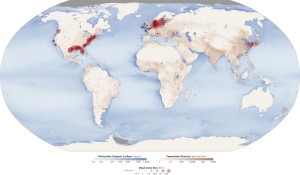Nitrification is the process by which ammonia is converted first into nitrites and then into nitrates, a form of nitrogen that can then be used by plants to grow. However, understanding how the nitrogen cycle works in marine environments is equally crucial.

Oxygen minimum zones (shows as red circles) are marine regions where many organisms cannot survive due to the reduced oxygen levels. (Image courtesy of the NASA Earth Observatory)
Until 1977, scientists believed that ammonium could only be oxidized by aerobic bacteria. Finding and identifying microbes that could handle the process anaerobically changed that notion. Anammox bacteria have been found in freshwater and marine environments as well as wastewater treatment plants. Marine anammoxbacteria are responsible for as much as half of the global marine nitrogen loss from oxygen minimum zones.
One kind of bacteria that has been found in all of the marine environments investigated thus far is CandidatusScalinduaand researchers wanted to better understand its role in the global nitrogen cycle. A team including DOE Joint Genome Institute researchers sequenced a community including these bacteria and compared the assembled genome of S. profunda to the only other available anammox bacterium metagenome assembly available thus far – a freshwater species.
The team detailed their findings in the May 2013 issue of Environmental Microbiology, noting that “[a]daptationsof Scalindua to the substrate limitation of the ocean may include highly expressed ammonium, nitrite and oligopeptide transport systems and pathways for the transport, oxidation, and assimilation of small organic compounds that may allow a more versatile lifestyle contributing to the competitive fitness of Scalindua in the marine realm.”